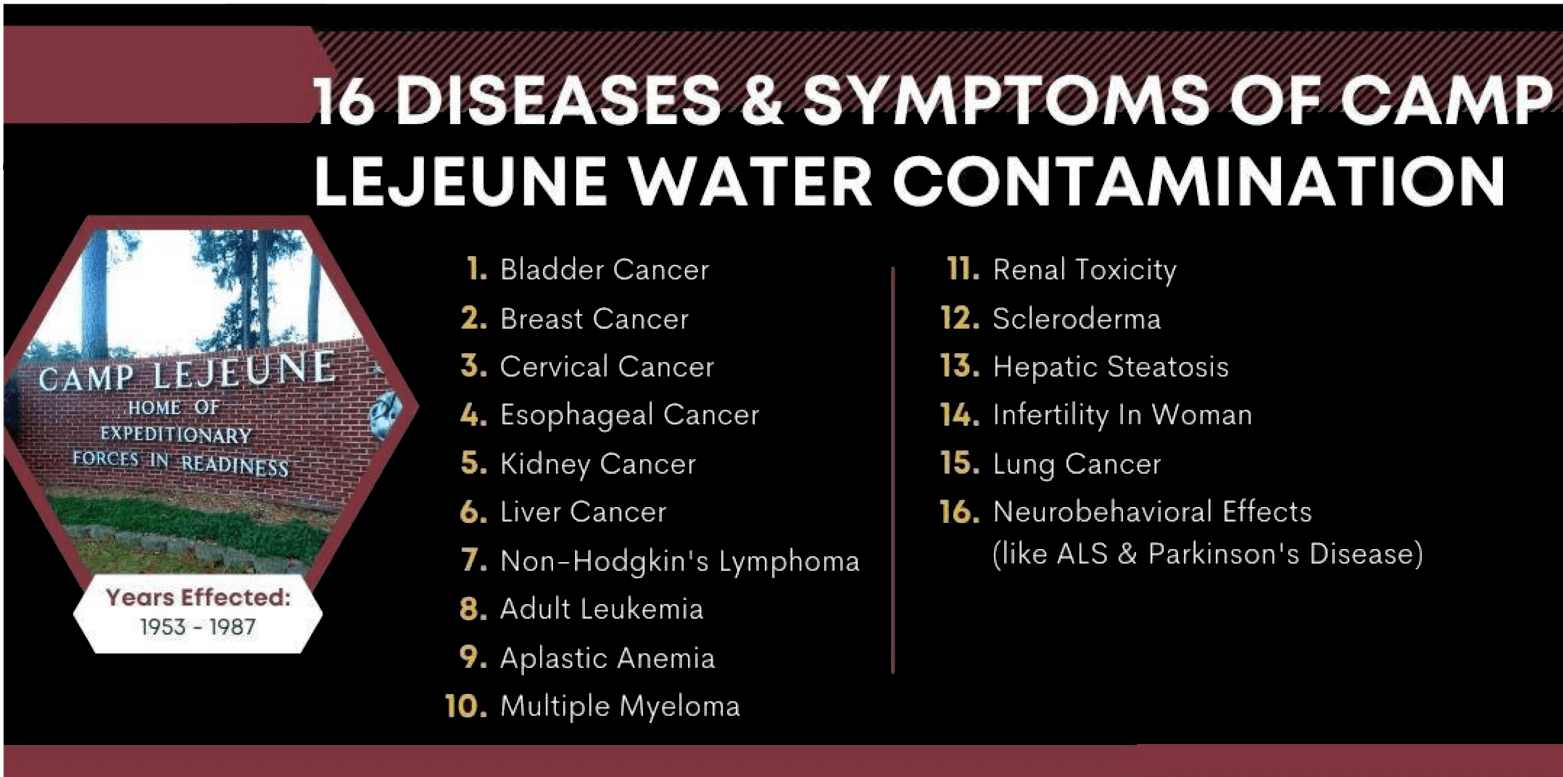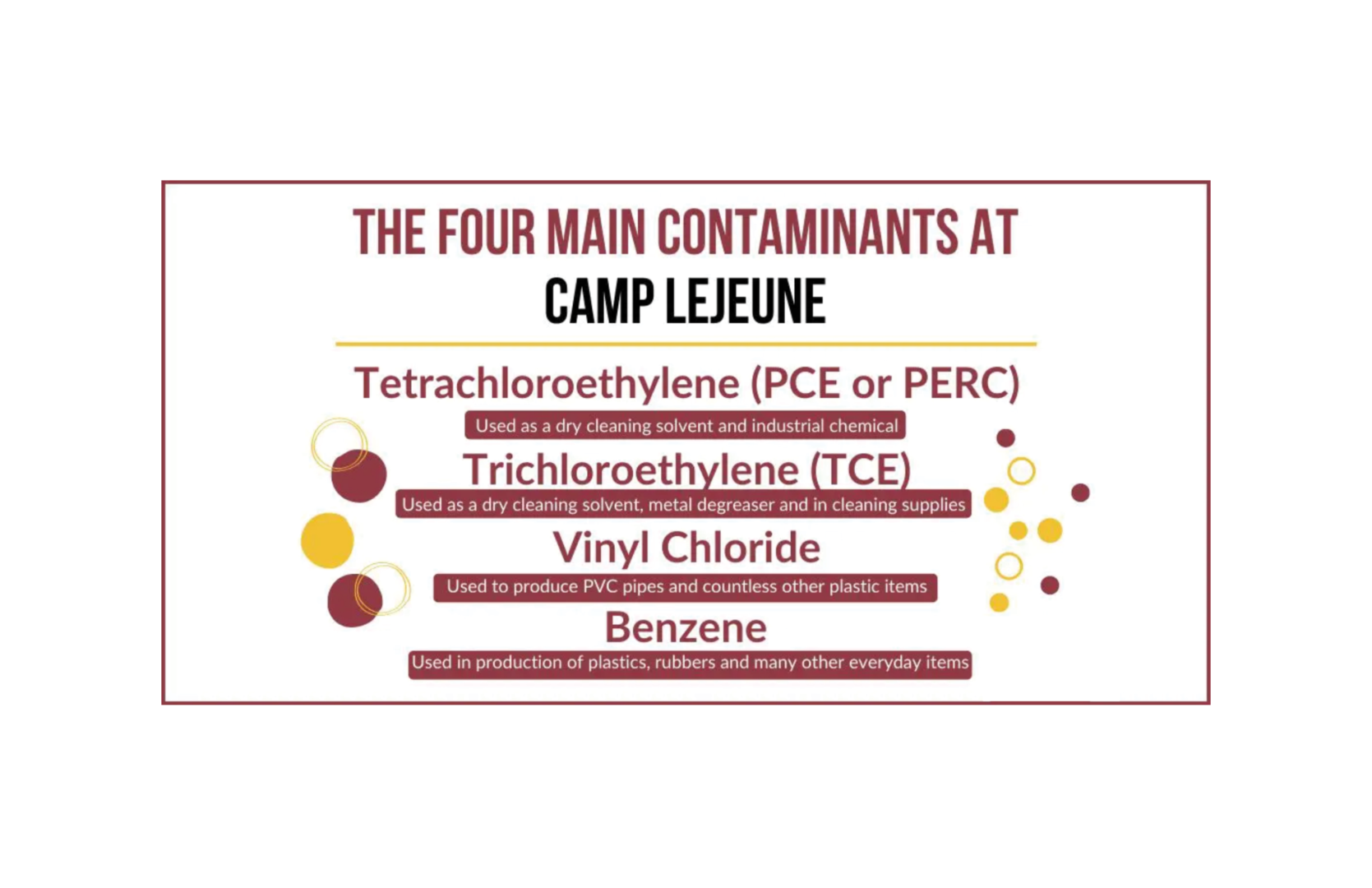Camp Lejeune
The Camp Lejeune Justice Act, which has been signed into law by President Biden as part of the PACT Act, will allow victims who meet the qualifying criteria to pursue legal action.
The Camp Lejeune Justice Act will initiate a mass tort lawsuit in the U.S. District Court for the Eastern District of North Carolina in the same sort of way multidistrict litigation is handled.

What To Do If You Have Experienced Symptoms Of Camp Lejeune's Water Contamination?
Contact a Law Firm as Soon as Possible as to Review Your Symptoms Assessing Damages Determining Liability and Establishing Your Case.

CAMP LEJEUNE WATER CONTAMINATION LAWSUIT
August 2022
President Biden has Signed the PACT Act Into Law. Veterans are now one step closer to securing the benefits they deserve, and those exposed to toxic water at Camp Lejeune can file their claims for compensation.
If You or a Loved One were Exposed to Contaminated Water at Camp Lejeune between 1953 and 1987, you may qualify for a lawsuit.
Over one million people, who were present at Camp Lejeune (North Carolina) (wiki) between 1953 and 1987, may have been exposed to toxic substances in the water.
Health Effects Of Contaminated Drinking Water At Camp Lejeune

People who may have been exposed to water contamination at Camp Lejeune include:
- Veterans
- Family members
- Workers
- And others
Also note Camp Lejeune is also Home to the I Marine Expeditionary Force (I MEF), who provide the Marine Corps with an Internationally Responsive, Expeditionary, and Fully scalable Marine Air-Ground Task Force (MAGTF)
You may qualify for the Camp Lejeune Water Contamination Lawsuit if you lived or worked at Camp Lejeune (NC) for 30+ days between August 1, 1953 and December 31, 1987.
The Camp Lejeune Contaminated Water Lawsuit can apply to you, a family member, or a loved one who lived at Camp Lejeune (North Carolina) and suffered health effects from the decades of water contamination that occurred.
Frequently Asked Questions
What Caused Camp Lejeune Water Contamination?
Water contamination at Camp Lejeune was caused by spills or leaks from underground storage tanks, waste disposal sites, businesses, and more.
Because of this, (see EPA) Volatile Organic Compounds (VOCs) were found in the water serving the base housing and a variety of other buildings.
These VOCs included:
- Dry cleaning solvents
- Degreasers
- And almost seventy (70) other hazardous chemicals
Toxic Substances Found In The Water At Marine Corps Base Camp Lejeune And Marine Corps Air Station New River
More than 1 million people may have been exposed to contaminated water at Camp Lejeune in North Carolina, and the full effects of that exposure may not be known for years or even decades.
Researchers are still working to understand how the exposure may have affected people’s health, but some conditions have been linked to water contamination.
According to the National Library of Medicine, the Water at Camp Lejeune was Contaminated with a Variety of Chemicals, Including Benzene, Chloroform, and Vinyl Chloride.
These Chemicals are Known to Cause Cancer, Birth defects, and other Serious Health Problems.
What To Do If You Have Experienced Symptoms Of Camp Lejeune's Water Contamination?
Contact a Law Firm as Soon as Possible as to Review Your Symptoms Assessing Damages Determining Liability and Establishing Your Case.
What Are The 16 Health Conditions And Symptoms Of Camp Lejeune Water Contamination?
- Sixteen (16) of the health conditions and symptoms that have been linked to exposure to the contaminated water at Camp Lejeune include:
Health Effects Of Contaminated Drinking Water At Camp Lejeune

1. Bladder Cancer
According to researchers, the contaminated water at Camp Lejeune may have increased the risk of bladder cancer among those exposed to it. Bladder cancer is a disorder in which malignant (cancer) cells develop in the bladder's tissues.
There are some risk factors that are common to many people. These include age, gender, smoking status, and exposure to environmental toxins. Bladder cancer is more common among older people, as their bodies have had longer to develop abnormalities in their cells.
Although there is no one definitive cure for bladder cancer, early detection and treatment can improve your chances of recovery and reduce your symptoms. Individuals at high risk of bladder cancer can take proactive measures to maintain their health by making lifestyle adjustments and receiving periodic screening examinations.
2. Breast Cancer
The second most common type of cancer linked to Camp Lejeune water contamination is breast cancer. Studies have shown that women who were exposed to the contaminated water at Camp Lejeune have a much higher risk of developing breast cancer than those who were not exposed.
There are a number of possible explanations for this increased risk. One theory is that the contaminants in the water can disrupt the normal function of the breasts and increase the risk of cancer. Another theory is that the contaminants can damage DNA, which can then lead to the development of cancer.
There are a number of symptoms that women should be aware of when it comes to breast cancer. These include a change in the size or shape of the breasts, a change in the texture of the skin on the breasts, a lump in the breast, and discharge from the nipple. If you experience any of these symptoms, it is important to see a doctor right away.
3. Cervical Cancer
Cervical cancer is another type of cancer that has been linked to exposure to contaminated water at Camp Lejeune. This type of cancer develops in the tissues of the cervix, which is the lower part of the uterus.
Cervical cancer is caused by a virus known as human papillomavirus (HPV). Researchers believe that the contaminated water at Camp Lejeune may have increased the risk of cervical cancer by exposing women to HPV.
There are a number of symptoms associated with cervical cancer. These include bleeding between periods, bleeding after sexual intercourse, and pain during sexual intercourse.
4. Esophageal Cancer
This particular type of cancer begins in the esophagus, which is the hollow, muscular tube that transports food and liquids from your mouth to your stomach. Esophageal cancer is relatively rare, accounting for only about 1% of all cancers diagnosed in the United States each year.
However, it is one of the deadliest types of cancer, with a five-year survival rate of only about 20%. This is because cancer often goes undetected until it has spread to other parts of the body.
Symptoms of esophageal cancer include difficulty swallowing, weight loss, and pain in the throat or back. Contaminated water at Camp Lejeune may have increased the risk of esophageal cancer by damaging the DNA of the cells in the esophagus.
5. Kidney Cancer
Kidney cancer begins in the cells of the kidney and can spread to other parts of the body. The kidneys are a pair of organs that filter waste from the blood and remove it from the body.
The contaminated water has been linked to an increased risk of kidney cancer. It is due to exposure to chemicals like benzene and trichloroethylene. The risk is highest among people who were exposed to the water for longer periods of time.
Symptoms of kidney cancer include blood in the urine, pain in the side, and a mass in the abdomen. If you experience any of these symptoms, it is important to see a doctor right away.
6. Liver Cancer
The contaminated water at Camp Lejeune has also been linked to an increased risk of liver cancer. The Agency for Toxic Substances and Disease Registry (ATSDR) found that men who were exposed to the contaminated water at Camp Lejeune were twice as likely to develop liver cancer as those who had not been exposed.
It is believed that the contaminated water may have increased the risk of liver cancer by exposing people to chemicals like benzene and trichloroethylene. These chemicals can damage DNA and lead to the development of cancer.
There are a number of symptoms associated with liver cancer. These include weight loss, fatigue, pain in the abdomen, and jaundice.
7. Non-Hodgkin's Lymphoma
The Risk of Developing Non-Hodgkin's Lymphoma was found to be two times greater for those who drank the contaminated water at Camp Lejeune. This is cancer that begins in the cells of the lymph system, which is part of the body's immune system.
The symptoms of non-Hodgkin's lymphoma can include swollen lymph nodes, fatigue, fever, and weight loss. Contaminated water at Camp Lejeune has the elements to create a toxic environment in the body and suppress the immune system.
It is important to see a doctor if you experience any of these symptoms. Early detection is important for the successful treatment of this type of cancer.
8. Adult Leukemia
Adult leukemia is the abnormal growth of blood cells in the bone marrow. This can crowd out healthy blood cells and lead to serious health problems. People who were exposed to the contaminated water at Camp Lejeune were found to be more likely to develop adult leukemia.
The symptoms of adult leukemia can include fatigue, fever, weight loss, and easy bruising or bleeding. Most people with adult leukemia will need treatment with chemotherapy or radiation.
The water at Camp Lejeune is contaminated, and it contains Benzene, a known carcinogen that has been linked to leukemia. If you were exposed to contaminated water, it is important to talk to your doctor about your risk for leukemia.
9. Aplastic Anemia
The chemicals in the water at Camp Lejeune have been linked to aplastic anemia, which is a condition in which the body does not produce enough new blood cells. Risk factors that have been linked to aplastic anemia include exposure to chemicals like benzene and trichloroethylene.
Symptoms of aplastic anemia can include fatigue, shortness of breath, and easy bruising or bleeding. The treatment for aplastic anemia is a bone marrow transplant.
The symptoms can be mild or severe, and they can come on suddenly or gradually. In a research study of people who were exposed to the contaminated water at Camp Lejeune, the risk for aplastic anemia was found to be increased.
10. Multiple Myeloma
The occurrence of this cancer is increased by 56% for those exposed to the Camp Lejeune water contamination. This cancer attacks plasma cells in the bone marrow and causes problems with the production of blood cells.
Multiple Myeloma is hard to diagnose in its early stages because it shares symptoms with other illnesses. These can include Fatigue, Bone pain or fractures, Frequent infections, Nausea and Anemia.
The exact cause of Multiple Myeloma is unknown, but it is thought to be caused by a combination of environmental and genetic factors.
11. Renal Toxicity
Another symptom that is common in individuals who have been exposed to contaminated water at Camp Lejeune is renal toxicity. Renal toxicity is damage to the kidneys that can lead to kidney failure.
Some of the symptoms associated with renal toxicity include Changes in urination, Frequent urination, Blood in the urine, swelling in the feet, ankles, or legs, Nausea and weakness.
This condition can be very serious and if you believe that you may have been exposed to contaminated water at Camp Lejeune, it is important to seek medical attention as soon as possible.
12. Scleroderma
Scleroderma is a condition that results in the hardening and thickening of the skin. It can also affect the tissues and organs inside the body, including the lungs, heart, and kidneys.
The symptoms of scleroderma vary depending on the organs affected. Skin symptoms may include Hardened thickened skin, Itching, Burning or swelling, and Raynaud's phenomenon (reduced blood flow to the extremities).
When scleroderma affects the internal organs, it can cause shortness of breath, Heartburn, Swelling in the arms and legs, Fatigue, and numbness or tingle in the fingers and toes.
There is no cure for scleroderma, but treatments are available to help manage the symptoms. Although the precise cause of scleroderma is still unknown, it is thought to be linked to an overactive immune system and contaminated water.
13. Hepatic Steatosis
One of the most common symptoms associated with Camp Lejeune water contamination is hepatic steatosis, more commonly known as fatty liver disease. This condition occurs when there is an accumulation of fat in the liver cells.
Symptoms of hepatic steatosis can include fatigue, weight loss, and pain in the upper right abdomen. In some cases, fatty liver disease can lead to more serious conditions, such as cirrhosis or liver cancer.
The treatment for hepatic steatosis generally involves lifestyle changes, such as diet and exercise. In some cases, medication may be necessary to control the symptoms.
14. Infertility In Women
An increased risk of infertility in women has also been linked to Camp Lejeune's polluted water. Infertility is defined as the inability to conceive after one year of unprotected sex.
There are many factors that can contribute to infertility, and it is often a complex condition with no clear cause. However, exposure to certain chemicals has been linked to an increased risk of infertility in women, and it is thought that the Camp Lejeune water contamination may have played a role.
This is a serious condition that can have a profound impact on a woman's life. If you believe you were exposed to contaminated water at Camp Lejeune, it's critical that you speak with your doctor about your fertility options.
15. Lung Cancer
Lung cancer is one of the deadliest types of cancer and can be difficult to catch in its early stages. The risk of lung cancer increases with exposure to certain chemicals, including benzene. Benzene is a known contaminant of the water at Camp Lejeune.
The most common symptom of lung cancer is a cough that doesn't go away. Other symptoms include Chest pain, Shortness of breath, Wheezing, and Loss of appetite. These symptoms can also be caused by other conditions, so it's important to see your doctor if you're experiencing any of them.
Lung cancer is treated with surgery, chemotherapy, and radiation therapy. The type of treatment depends on the stage of cancer and the individual patient.
16. Neurobehavioral Effects (Like ALS & Parkinson's Disease)
Neurobehavioral effects have been reported in children exposed to VOCs in drinking water. These effects include problems with attention, learning, and social interactions as well as aggressive behavior.
Contaminated water at Camp Lejeune was also linked to an increased risk of Parkinson’s disease, amyotrophic lateral sclerosis (ALS), and other neurological diseases.
Researchers are still working to understand all of the potential health effects of exposure to VOCs. These neurobehavioral effects are of particular concern because they can last a lifetime.
What To Do If You Have Experienced Symptoms Of Camp Lejeune's Water Contamination?
- Contact a Law Firm as Soon as Possible as to Review Your Symptoms Assessing Damages Determining Liability and Establishing Your Case
Over One Million People, who were present at Camp Lejeune (North Carolina) between 1953 and 1987, may have been exposed to toxic substances in the water.
People who may have been exposed to water contamination at Camp Lejeune include:
- Veterans
- Family members
- Workers
- And others
The Main Health Issues and Symptoms Linked to Camp Lejeune Water Contamination Include:
Other associated conditions include:
The ATSDR is also conducting a more general healthy study of the Several Cancers and Chronic Conditions Linked to Camp Lejeune because people were exposed to chemicals known to cause those ailments.
The U.S. Department of Veterans Affairs announced a list of presumptive conditions related to Water Contamination at Camp Lejeune.
The Veterans Administration allows members of the armed services to seek benefits for the conditions outlined on the aforementioned link.
Please Note:
Disability benefits secured through Veterans Affairs are available to only former military personnel, and not family members.
What Toxic Substances Were In The Water At Camp Lejeune?

Volatile organic compounds (VOCs) were found in the water serving the base housing and a variety of other buildings.
These VOCs included:
- Dry cleaning solvents
- Degreasers
- And almost seventy (70) other hazardous chemicals
Scientific and medical evidence has linked these chemicals present in water to a number of serious health conditions.
The sources of contamination at Camp Lejeune are varied, but the sources of a few chemicals can be pinpointed.
According to the Centers for Disease Control (CDC), water from the Tarawa Terrace Treatment Plant was primarily contaminated by PCE (perchloroethylene or tetrachloroethylene), which reportedly originated from a dry cleaning business off-base.
The following four (4) chemicals were found in Camp Lejeune water sources:
1. Tetrachloroethylene (PCE Or PERC)
Tetrachloroethylene (also known as Perchloroethylene) is an industrial chemical used in:
- Dry-cleaning fabrics
- Degreasing metal machinery
- Manufacturing other chemicals
- Producing paint
- And more
Exposure to Tetrachloroethylene can lead to bladder cancer and other health effects.
2. Trichloroethylene (TCE)
Trichloroethylene (TCE) is used as a degreaser product for metal machinery.
Ingested, inhaled or absorbed through the skin, exposure to Trichloroethylene (TCE) can potentially lead to:
- Kidney Cancer
- Non-Hodgkin Lymphoma
- Other cancers
- Cardiac effects
3. Vinyl Chloride
Vinyl Chloride is an odorless gas used in the production of many plastic products including PVC pipes and wire coatings.
Vinyl Chloride was previously used in products like makeup, refrigerants, and household aerosols.
Vinyl chloride has been heavily linked to liver cancer and other cancers.
4. Benzene
Benzene is an organic compound commonly used in industrial chemical operations.
In the ATSDR assessment, it was found that consuming water contaminated with Benzene is linked to Leukemias and Non-Hodgkin Lymphoma.
Benzene may also be linked to Multiple Myeloma.
Camp Lejeune Justice Act

A new bill that affords new benefits for veterans has been officially signed into law by President Biden
The Camp Lejeune Justice Act is a massive step forward for qualifying service members, family, workers, and others affected by toxic water in recovering disability compensation for their ailments.
The Camp Lejeune Justice Act would allow individuals to file a claim in the U.S. District Court for the Eastern District of Northern Carolina and recover damages for harm from exposure to contaminated water at the Camp Lejeune Marine Corps Base between August 1, 1953 and December 31, 1987.
The bill outlines that anyone exposed to toxic water at Camp Lejeune for 30 days is able to pursue legal action.
The 30-day threshold can be met in a non-continuous manner:
- If a family member visited at various times totaling 30 days between 1953 and 1987 - they have a viable claim.
The bill also prohibits the United States Government from "asserting specified immunity from litigation in response to such a lawsuit."
It also overrides a North Carolina state law that has made actions such as this previously impossible.
How Did The Camp Lejeune Justice Act Come About?
- The Agency for Toxic Substances and Disease Registry (ATSDR) and the Department of Defense found that upwards of one million people present at Camp Lejeune were exposed to contaminated water that can lead to devastating health effects.
- Years prior to these recent developments, a number of lawsuits were filed over water contamination at Camp Lejeune.
- Over 850 cases were consolidated into an MDL, but the lawsuits were dismissed due to a North Carolina law known as a statute of repose, which stated that legal action could not be brought since the alleged water contamination occurred more than three (3) years prior to filing suit.
The resulting public outrage led to the proposal of the Camp Lejeune Justice Act years later.
For Those Who Resided At Camp Lejeune, How Is The Camp Lejeune Justice Act Different Than Other Bills?
In 2012, Congress passed H.R.1627 - Honoring America's Veterans and Caring for Camp Lejeune Families Act, which granted some benefits to those who were exposed (both veterans and family members) if they met certain standards.
This Bill would provide health care benefits to a family member, not VA compensation benefits.
A Veteran would be able to secure health care benefits and VA compensation benefits.
Then, in 2017, Congress passed an additional statute that granted more benefits and expanded upon the conditions associated with exposure at the base.
The Camp Lejeune Justice Act is different than previous bills in that it does not only provide health care or disability benefits, it provides a legal route for affected individuals to seek compensation for their exposure-related medical issues.
Filing A Camp Lejeune Water Contamination Lawsuit
Filing a lawsuit for your or your loved one's injuries or conditions can seem incredibly daunting.
With the help of experienced legal representation, the process can be simplified.
Who Can File A Claim In The Camp Lejeune Water Contamination Lawsuit?
As stated in the Veterans Administration release and the Camp Lejeune Justice Act, anybody who resided at the marine corps base for at least thirty (30) days, while The Camp Lejeune Accident was occurring, may be eligible to file a claim.
This includes active duty and former service members, family members living on base, non-military staff, families of deceased, and even in-utero victims who were not yet born when their mother was residing at Camp Lejeune.
It's important to note that if you were dishonorably discharged, you may not be eligible for disability benefits or disability compensation.
Families of dishonorably discharged military personnel are also not eligible to file suit or apply for benefits.
Gathering Evidence
Quality evidence is the cornerstone of any successful personal injury or mass tort case.
Evidence relating to water contamination can include a number of documents relating to your or a loved one's time spent at the marine corps base.
Evidence in a Camp Lejeune water contamination lawsuit may include:
- Documents proving residence at Camp Lejeune
- Military service records indicating dates and locations served
- Medical records and diagnoses
- Medical bills
- Travel records
- Health care information
- Records on disability benefits or VA compensation benefits
What To Do If You Have Experienced Symptoms Of Camp Lejeune's Water Contamination?
- Contact a Law Firm as Soon as Possible as to Review Your Symptoms Assessing Damages Determining Liability and Establishing Your Case.
When you have gathered pieces of key evidence, a lawyer will help you to refine your case and assess damages.
Damages are Any Losses, Both Physical and Mental-Emotional, that a person incurs as a result of an injury at no fault of their own.
Damages are the total amount the defendant is liable to pay to the plaintiff to compensate for the damage that they have caused.
Damages in a Camp Lejeune water contamination lawsuit may include:
- Medical bills
- Pain and suffering
- Lost wages
- Disability benefits
- Loss of companionship, consortium, enjoyment of life, and earning capacity
- Permanent disability
What To Do If You Have Experienced Symptoms Of Camp Lejeune's Water Contamination?
- Contact a Law Firm as Soon as Possible as to Review Your Symptoms Assessing Damages Determining Liability and Establishing Your Case.
In a Camp Lejeune Contamination Case, the liable parties or defendants may include, but are not limited to:
- The Federal Government
- Other Governmental or Regulatory Agencies
- Businesses that may have Contributed to Tainted Water Supplies
- Any Other Person or Group that Acted in a Negligent Manner that Contributed to an Injury or Diagnosis
What To Do If You Have Experienced Symptoms Of Camp Lejeune's Water Contamination?
- Contact a Law Firm as Soon as Possible as to Review Your Symptoms Assessing Damages Determining Liability and Establishing Your Case.
